六、JDBC操作数据库
文章目录
- JDBC概述
- 概念
- JDBC本质
- JDBC好处
- JDBC快速入门
- JDBC API详解
- DriverManager
- Connection
- 获取执行SQL的对象
- 管理事务
- Statement
- 概述
- 代码实现
- ResultSet
- 概述
- 代码实现
- PreparedStatement
- SQL注入
- 代码模拟SQL注入问题
- PreparedStatement概述
- 使用PreparedStatement改进
- PreparedStatement原理
- 数据库连接池
- 数据库连接池简介
- 数据库连接池实现
- Driud使用
- JDBC练习
- 需求
- 案例实现
- 环境准备
- 查询所有
- 添加数据
- 修改数据
- 删除数据
JDBC概述
概念
JDBC( Java DataBase Connectivity )就是使用Java语言操作关系型数据库的一套API。
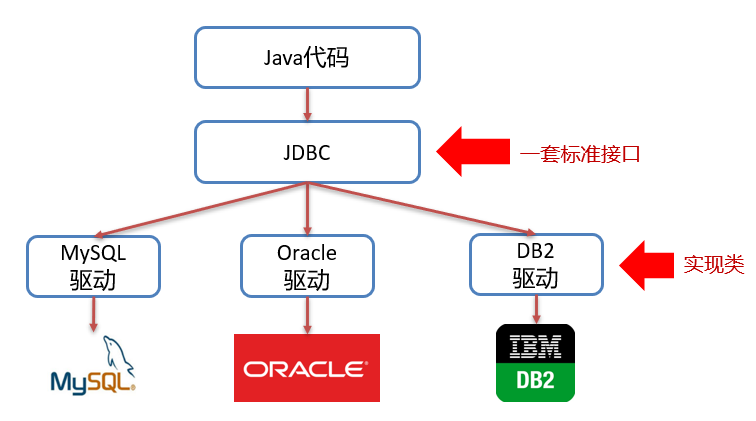
我们开发的同一套Java代码是无法操作不同的关系型数据库,因为每一个关系型数据库的底层实现细节都不一样。如果这样,问题就很大了,在公司中可以在开发阶段使用的是MySQL数据库,而上线时公司最终选用oracle数据库,我们就需要对代码进行大批量修改,这显然并不是我们想看到的。我们要做到的是同一套Java代码操作不同的关系型数据库,而此时sun公司就指定了一套标准接口(JDBC),JDBC中定义了所有操作关系型数据库的规则。众所周知接口是无法直接使用的,我们需要使用接口的实现类,而这套实现类(称之为:驱动)就由各自的数据库厂商给出。
JDBC本质
- 官方(sun公司)定义的一套操作所有关系型数据库的规则,即接口。
- 各个数据库厂商去实现这套接口,提供数据库驱动jar包。
- 我们可以使用这套接口(JDBC)编程,真正执行的代码是驱动jar包中的实现类。
JDBC好处
- 各数据库厂商使用相同的接口,Java代码不需要针对不同数据库分别开发。
- 可随时替换底层数据库,访问数据库的Java代码基本不变。
以后编写操作数据库的代码只需要面向JDBC(接口),操作哪儿个关系型数据库就需要导入该数据库的驱动包,如需要操作MySQL数据库,就需要再项目中导入MySQL数据库的驱动包。如下图就是MySQL驱动包:

JDBC快速入门
导入驱动 jar 包
mysql mysql-connector-java 8.0.32
1、注册驱动。2、获取连接。3、定义sql。4、获取执行sql的对象 Statement。5、执行sql。6、处理结果。7、释放资源。
/*** JDBC快速入门*/
public class JDBCDemo {public static void main(String[] args) throws Exception {//1. 注册驱动//Class.forName("com.mysql.jdbc.Driver");//2. 获取连接String url = "jdbc:mysql://127.0.0.1:3306/db1";String username = "root";String password = "1234";// Java代码需要发送SQL给MySQL服务端,就需要先建立连接Connection conn = DriverManager.getConnection(url, username, password);//3. 定义sqlString sql = "update account set money = 2000 where id = 1";//4. 获取执行sql的对象 Statement// 执行SQL语句需要SQL执行对象,而这个执行对象就是Statement对象Statement stmt = conn.createStatement();//5. 执行sqlint count = stmt.executeUpdate(sql);//受影响的行数//6. 处理结果System.out.println(count);//7. 释放资源stmt.close();conn.close();}
}
JDBC API详解
DriverManager
DriverManager(驱动管理类)作用:== 注册驱动和获取连接==。
-
注册驱动
java.sql.DriverManager#registerDriver(java.sql.Driver)
registerDriver方法是用于注册驱动的。我们查询MySQL提供的com.mysql.cj.jdbc.Driver类,实现源码如下:
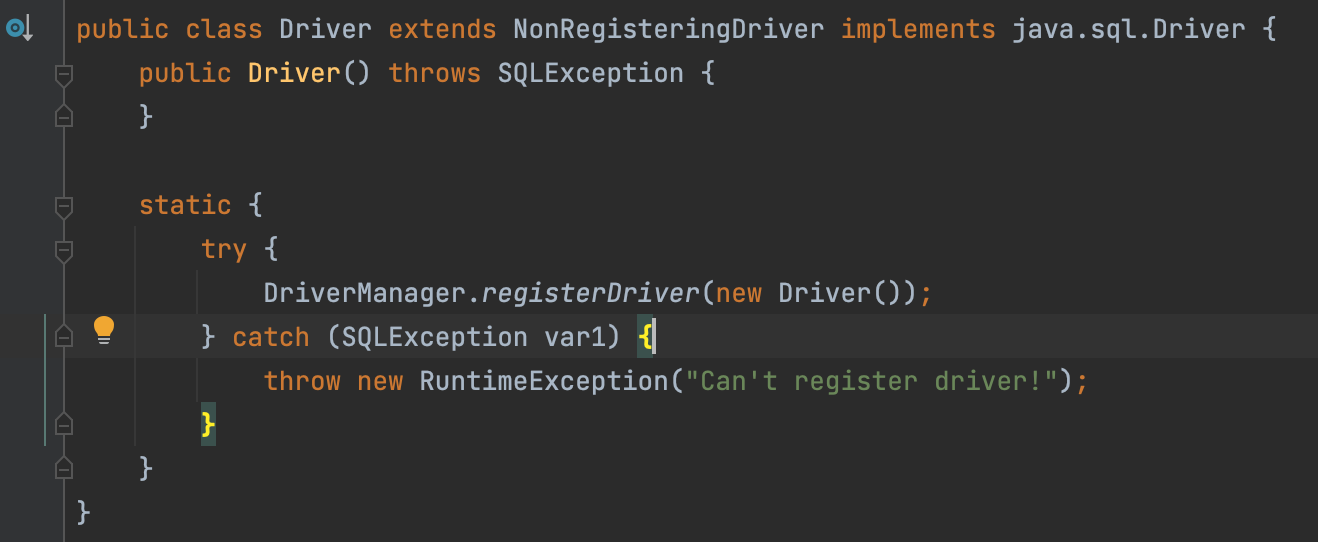 在该类中的静态代码块中已经执行了
在该类中的静态代码块中已经执行了 DriverManager对象的registerDriver()方法进行驱动的注册了,那么我们只需要加载Driver类,该静态代码块就会执行。而Class.forName("com.mysql.cj.jdbc.Driver");就可以加载Driver类。MySQL 5之后的驱动包,可以省略注册驱动的步骤。自动加载jar包中META-INF/services/java.sql.Driver文件中的驱动类。
-
获取数据库连接
java.sql.DriverManager#getConnection(String url, String user, String password)
此方法尝试建立给定数据库URL的连接。参数说明如下:- url : 连接路径
- user :用户名
- poassword :密码
url语法:jdbc:mysql://ip地址(域名):端口号/数据库名称?参数键值对1&参数键值对2…
示例:jdbc:mysql://127.0.0.1:3306/db1
如果连接的是本机mysql服务器,并且mysql服务默认端口是3306,则url可以简写为:jdbc:mysql:///数据库名称?参数键值对
配置 useSSL=false 参数,禁用安全连接方式,解决警告提示
Connection
Connection(数据库连接对象)的作用:获取执行SQL的对象和管理事务。
获取执行SQL的对象
-
普通执行SQL对象。
Statement createStatement() -
预编译SQL的执行SQL对象:防止SQL注入。
PreparedStatement prepareStatement(sql)通过这种方式获取的
PreparedStatementSQL语句执行对象是我们一会重点要进行讲解的,它可以防止SQL注入。 -
执行存储过程的对象。
CallableStatement prepareCall(sql)通过这种方式获取的
CallableStatement执行对象是用来执行存储过程的,而存储过程在MySQL中不常用,所以这个我们将不进行讲解。
管理事务
先回顾一下MySQL事务管理的操作:
- 开启事务:BEGIN; 或者 START TRANSACTION;
- 提交事务:COMMIT;
- 回滚事务:ROLLBACK;
MySQL默认是自动提交事务。
接下来学习JDBC事务管理的方法。
-
开启事务:
参数autoCommit 表示是否自动提交事务,true表示自动提交事务,false表示手动提交事务;而开启事务需要将该参数设为为false。void setAutoCommit(boolean autoCommit) throws SQLException; -
提交事务:
void commit() throws SQLException; -
回滚事务:
void rollback() throws SQLException;
JDBC使用事务的具体代码实现如下:
public static void main(String[] args) throws Exception {//1. 注册驱动//Class.forName("com.mysql.jdbc.Driver");//2. 获取连接:如果连接的是本机mysql并且端口是默认的 3306 可以简化书写String url = "jdbc:mysql:///db1?useSSL=false";String username = "root";String password = "1234";Connection conn = DriverManager.getConnection(url, username, password);//3. 定义sqlString sql1 = "update account set money = 3000 where id = 1";String sql2 = "update account set money = 3000 where id = 2";//4. 获取执行sql的对象 StatementStatement stmt = conn.createStatement();try {// ============开启事务==========conn.setAutoCommit(false);//5. 执行sqlint count1 = stmt.executeUpdate(sql1);//受影响的行数//6. 处理结果System.out.println(count1);int i = 3 / 0;//5. 执行sqlint count2 = stmt.executeUpdate(sql2);//受影响的行数//6. 处理结果System.out.println(count2);// ============提交事务==========//程序运行到此处,说明没有出现任何问题,则需求提交事务conn.commit();} catch (Exception e) {// ============回滚事务==========//程序在出现异常时会执行到这个地方,此时就需要回滚事务conn.rollback();e.printStackTrace();}//7. 释放资源stmt.close();conn.close();}
Statement
概述
Statement对象的作用就是用来执行SQL语句。而针对不同类型的SQL语句使用的方法也不一样。
- 执行DDL、DML语句
int executeUpdate(String sql) throws SQLException; - 执行DQL语句
ResultSet executeQuery(String sql) throws SQLException;
代码实现
- 执行DML语句
/*** 执行DML语句* @throws Exception*/
@Test
public void testDML() throws Exception {//1. 注册驱动//Class.forName("com.mysql.jdbc.Driver");//2. 获取连接:如果连接的是本机mysql并且端口是默认的 3306 可以简化书写String url = "jdbc:mysql:///db1?useSSL=false";String username = "root";String password = "1234";Connection conn = DriverManager.getConnection(url, username, password);//3. 定义sqlString sql = "update account set money = 3000 where id = 1";//4. 获取执行sql的对象 StatementStatement stmt = conn.createStatement();//5. 执行sqlint count = stmt.executeUpdate(sql);//执行完DML语句,受影响的行数//6. 处理结果//System.out.println(count);if(count > 0){System.out.println("修改成功~");}else{System.out.println("修改失败~");}//7. 释放资源stmt.close();conn.close();
}
- 执行DDL语句
/*** 执行DDL语句* @throws Exception*/
@Test
public void testDDL() throws Exception {//1. 注册驱动//Class.forName("com.mysql.jdbc.Driver");//2. 获取连接:如果连接的是本机mysql并且端口是默认的 3306 可以简化书写String url = "jdbc:mysql:///db1?useSSL=false";String username = "root";String password = "1234";Connection conn = DriverManager.getConnection(url, username, password);//3. 定义sqlString sql = "drop database db2";//4. 获取执行sql的对象 StatementStatement stmt = conn.createStatement();//5. 执行sqlint count = stmt.executeUpdate(sql);//执行完DDL语句,可能是0//6. 处理结果System.out.println(count);//7. 释放资源stmt.close();conn.close();
}
注意:开发很少使用Java代码操作DDL语句。
ResultSet
概述
ResultSet(结果集对象)作用:封装了SQL查询语句的结果。
而执行了DQL语句后就会返回该对象,对应执行DQL语句的方法如下:
ResultSet executeQuery(sql);// 执行DQL 语句,返回 ResultSet 对象
那么我们就需要从 ResultSet 对象中获取我们想要的数据。ResultSet 对象提供了操作查询结果数据的方法,如下:
next()方法
作用:将光标从当前位置向前移动一行;判断当前行是否为有效行。
方法返回值说明:true:有效行,当前行有数据;false:无效行,当前行没有数据。
boolean next() throws SQLException;
getXxxx()方法
xxx : 数据类型;如: int getInt(参数) ;String getString(参数)
参数:int类型的参数:列的编号,从1开始;String类型的参数:列的名称。
Xxxx getXxxx(参数) throws SQLException;
代码实现
/*** 执行DQL* @throws Exception*/
@Test
public void testResultSet() throws Exception {//1. 注册驱动//Class.forName("com.mysql.jdbc.Driver");//2. 获取连接:如果连接的是本机mysql并且端口是默认的 3306 可以简化书写String url = "jdbc:mysql:///db1?useSSL=false";String username = "root";String password = "1234";Connection conn = DriverManager.getConnection(url, username, password);//3. 定义sqlString sql = "select * from account";//4. 获取statement对象Statement stmt = conn.createStatement();//5. 执行sqlResultSet rs = stmt.executeQuery(sql);//6. 处理结果, 遍历rs中的所有数据/* // 6.1 光标向下移动一行,并且判断当前行是否有数据while (rs.next()){//6.2 获取数据 getXxx()int id = rs.getInt(1);String name = rs.getString(2);double money = rs.getDouble(3);System.out.println(id);System.out.println(name);System.out.println(money);System.out.println("--------------");}*/// 6.1 光标向下移动一行,并且判断当前行是否有数据while (rs.next()){//6.2 获取数据 getXxx()int id = rs.getInt("id");String name = rs.getString("name");double money = rs.getDouble("money");System.out.println(id);System.out.println(name);System.out.println(money);System.out.println("--------------");}//7. 释放资源rs.close();stmt.close();conn.close();
}
PreparedStatement
SQL注入
SQL注入是通过操作输入来修改事先定义好的SQL语句,用以达到执行代码对服务器进行攻击的方法。例如输入 ' or '1' ='1这样的字样。
那么该如何解决呢?这里就可以将SQL执行对象 Statement 换成 PreparedStatement 对象。
代码模拟SQL注入问题
@Test
public void testLogin() throws Exception {//2. 获取连接:如果连接的是本机mysql并且端口是默认的 3306 可以简化书写String url = "jdbc:mysql:///db1?useSSL=false";String username = "root";String password = "1234";Connection conn = DriverManager.getConnection(url, username, password);// 接收用户输入 用户名和密码String name = "sjdljfld";String pwd = "' or '1' = '1";String sql = "select * from tb_user where username = '"+name+"' and password = '"+pwd+"'";// 获取stmt对象Statement stmt = conn.createStatement();// 执行sqlResultSet rs = stmt.executeQuery(sql);// 判断登录是否成功if(rs.next()){System.out.println("登录成功~");}else{System.out.println("登录失败~");}//7. 释放资源rs.close();stmt.close();conn.close();
}
上面代码是将用户名和密码拼接到sql语句中,拼接后的sql语句如下:
select * from tb_user where username = 'sjdljfld' and password = ''or '1' = '1'
从上面语句可以看出条件 username = 'sjdljfld' and password = '' 不管是否满足,而 or 后面的 '1' = '1' 是始终满足的,最终条件是成立的,就可以正常的进行登陆了。接下来我们来学习PreparedStatement对象。
PreparedStatement概述
PreparedStatement作用:预编译SQL语句并执行,预防SQL注入问题。
-
获取 PreparedStatement 对象
// SQL语句中的参数值,使用?占位符替代 String sql = "select * from user where username = ? and password = ?"; // 通过Connection对象获取,并传入对应的sql语句 PreparedStatement pstmt = conn.prepareStatement(sql); -
设置参数值
上面的sql语句中参数使用 ? 进行占位,在执行之前肯定要设置这些 ? 的值。PreparedStatement对象:setXxx(参数1,参数2):给 ? 赋值
- Xxx:数据类型 ; 如 setInt (参数1,参数2)
- 参数:
- 参数1: ?的位置编号,从1 开始
- 参数2: ?的值
-
执行SQL语句
executeUpdate(); 执行DDL语句和DML语句。
executeQuery(); 执行DQL语句。
注意:调用这两个方法时不需要传递SQL语句,因为获取SQL语句执行对象时已经对SQL语句进行预编译了。
使用PreparedStatement改进
@Test
public void testPreparedStatement() throws Exception {//2. 获取连接:如果连接的是本机mysql并且端口是默认的 3306 可以简化书写String url = "jdbc:mysql:///db1?useSSL=false";String username = "root";String password = "1234";Connection conn = DriverManager.getConnection(url, username, password);// 接收用户输入 用户名和密码String name = "zhangsan";String pwd = "' or '1' = '1";// 定义sqlString sql = "select * from tb_user where username = ? and password = ?";// 获取pstmt对象PreparedStatement pstmt = conn.prepareStatement(sql);// 设置?的值pstmt.setString(1,name);pstmt.setString(2,pwd);// 执行sqlResultSet rs = pstmt.executeQuery();// 判断登录是否成功if(rs.next()){System.out.println("登录成功~");}else{System.out.println("登录失败~");}//7. 释放资源rs.close();pstmt.close();conn.close();
}
执行上面语句就可以发现不会出现SQL注入漏洞问题了。那么PreparedStatement又是如何解决的呢?它是将特殊字符进行了转义,转义的SQL如下:
select * from tb_user where username = 'sjdljfld' and password = '\'or \'1\' = \'1'
PreparedStatement原理
PreparedStatement 好处:预编译SQL,性能更高。防止SQL注入:将敏感字符进行转义。
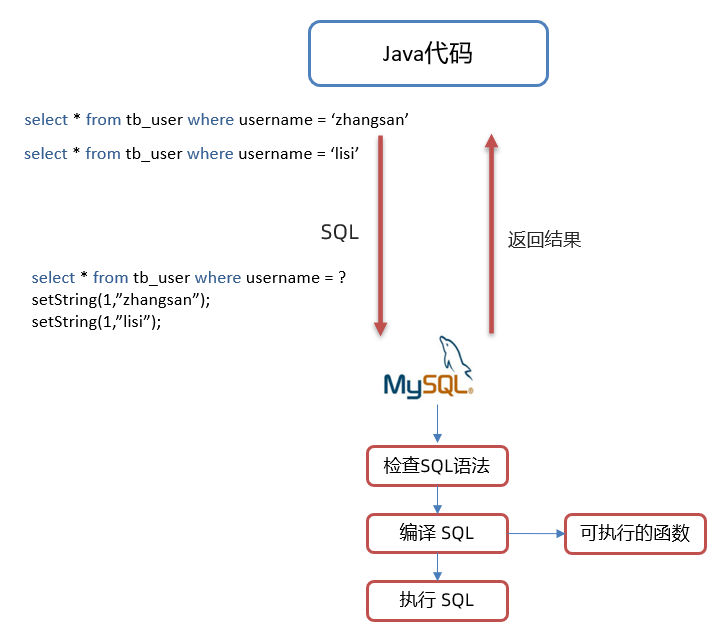
Java代码操作数据库流程如图所示:
- 将sql语句发送到MySQL服务器端。
- MySQL服务端会对sql语句进行如下操作。
- 检查SQL语句
检查SQL语句的语法是否正确。 - 编译SQL语句。将SQL语句编译成可执行的函数。
检查SQL和编译SQL花费的时间比执行SQL的时间还要长。如果我们只是重新设置参数,那么检查SQL语句和编译SQL语句将不需要重复执行。这样就提高了性能。 - 执行SQL语句
- 检查SQL语句
接下来我们通过查询日志来看一下原理。
-
开启预编译功能。
在代码中编写url时需要加上以下参数。而我们之前根本就没有开启预编译功能,只是解决了SQL注入漏洞。useServerPrepStmts=true -
配置MySQL执行日志(重启mysql服务后生效)。
在mysql配置文件(my.ini)中添加如下配置log-output=FILE general-log=1 general_log_file="D:\mysql.log" slow-query-log=1 slow_query_log_file="D:\mysql_slow.log" long_query_time=2 -
Java测试代码如下:
/*** PreparedStatement原理* @throws Exception*/ @Test public void testPreparedStatement2() throws Exception {//2. 获取连接:如果连接的是本机mysql并且端口是默认的 3306 可以简化书写// useServerPrepStmts=true 参数开启预编译功能String url = "jdbc:mysql:///db1?useSSL=false&useServerPrepStmts=true";String username = "root";String password = "1234";Connection conn = DriverManager.getConnection(url, username, password);// 接收用户输入 用户名和密码String name = "zhangsan";String pwd = "' or '1' = '1";// 定义sqlString sql = "select * from tb_user where username = ? and password = ?";// 获取pstmt对象PreparedStatement pstmt = conn.prepareStatement(sql);Thread.sleep(10000);// 设置?的值pstmt.setString(1,name);pstmt.setString(2,pwd);ResultSet rs = null;// 执行sqlrs = pstmt.executeQuery();// 设置?的值pstmt.setString(1,"aaa");pstmt.setString(2,"bbb");// 执行sqlrs = pstmt.executeQuery();// 判断登录是否成功if(rs.next()){System.out.println("登录成功~");}else{System.out.println("登录失败~");}//7. 释放资源rs.close();pstmt.close();conn.close(); } -
执行SQL语句,查看
D:\mysql.log日志如下:
 上图中第三行中的
上图中第三行中的 Prepare是对SQL语句进行预编译。第四行和第五行是执行了两次SQL语句,而第二次执行前并没有对SQL进行预编译。
小结
- 在获取PreparedStatement对象时,将sql语句发送给mysql服务器进行检查,编译(这些步骤很耗时)。
- 执行时就不用再进行这些步骤了,速度更快。
- 如果sql模板一样,则只需要进行一次检查、编译。
数据库连接池
数据库连接池简介
- 数据库连接池是个容器,负责分配、管理数据库连接(Connection)
- 它允许应用程序重复使用一个现有的数据库连接,而不是再重新建立一个;
- 释放空闲时间超过最大空闲时间的数据库连接来避免因为没有释放数据库连接而引起的数据库连接遗漏
- 数据库连接池的好处
- 资源重用
- 提升系统响应速度
- 避免数据库连接遗漏
之前我们代码中使用连接是没有使用都创建一个Connection对象,使用完毕就会将其销毁。这样重复创建销毁的过程是特别耗费计算机的性能的及消耗时间的。
而数据库使用了数据库连接池后,就能达到Connection对象的复用,如下图:

连接池是在一开始就创建好了一些连接(Connection)对象存储起来。用户需要连接数据库时,不需要自己创建连接,而只需要从连接池中获取一个连接进行使用,使用完毕后再将连接对象归还给连接池;这样就可以起到资源重用,也节省了频繁创建连接销毁连接所花费的时间,从而提升了系统响应的速度。
数据库连接池实现
-
标准接口:DataSource
官方(SUN) 提供的数据库连接池标准接口,由第三方组织实现此接口。该接口提供了获取连接的功能:Connection getConnection()那么以后就不需要通过
DriverManager对象获取Connection对象,而是通过连接池(DataSource)获取Connection对象。 -
常见的数据库连接池
- DBCP
- C3P0
- Druid
我们现在使用更多的是Druid,它的性能比其他两个会好一些。Druid连接池是阿里巴巴开源的数据库连接池项目,功能强大,性能优秀,是Java语言最好的数据库连接池之一。
Driud使用
- 导入jar包 druid-1.1.12.jar
- 定义配置文件
- 加载配置文件
- 获取数据库连接池对象
- 获取连接
现在通过代码实现,首先需要先将druid的jar包放到项目下的lib下并添加为库文件。
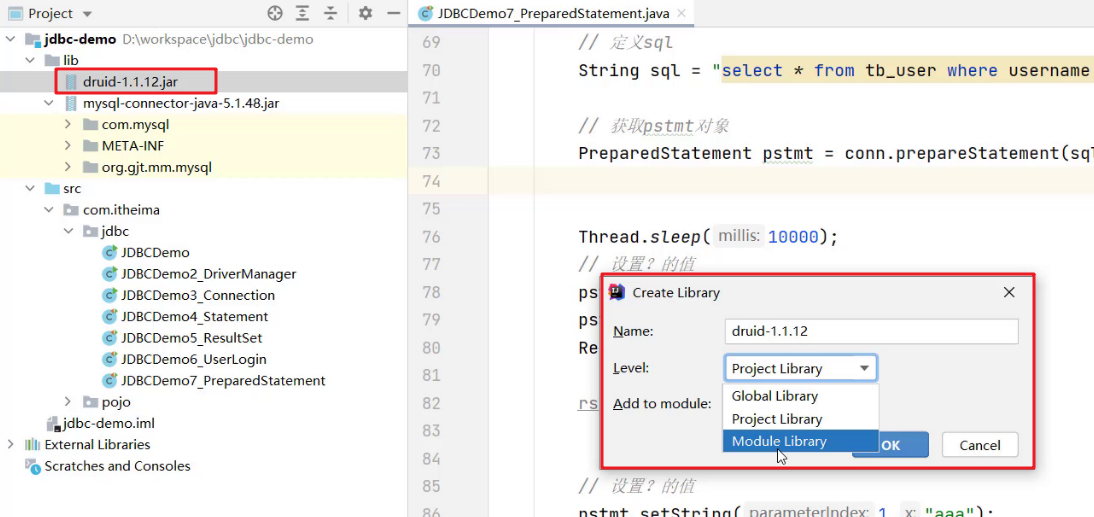 项目结构如下:
项目结构如下:
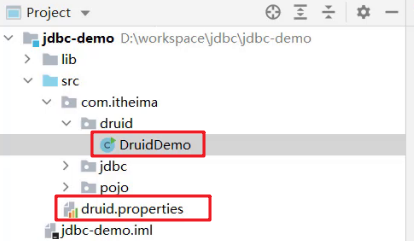
编写配置文件如下:
driverClassName=com.mysql.jdbc.Driver
url=jdbc:mysql:///db1?useSSL=false&useServerPrepStmts=true
username=root
password=1234
# 初始化连接数量
initialSize=5
# 最大连接数
maxActive=10
# 最大等待时间
maxWait=3000
使用druid的代码如下:
/*** Druid数据库连接池演示*/
public class DruidDemo {public static void main(String[] args) throws Exception {//1.导入jar包//2.定义配置文件//3. 加载配置文件Properties prop = new Properties();prop.load(new FileInputStream("jdbc-demo/src/druid.properties"));//4. 获取连接池对象DataSource dataSource = DruidDataSourceFactory.createDataSource(prop);//5. 获取数据库连接 ConnectionConnection connection = dataSource.getConnection();System.out.println(connection); //获取到了连接后就可以继续做其他操作了//System.out.println(System.getProperty("user.dir"));}
}
JDBC练习
需求
完成商品品牌数据的增删改查操作
- 查询:查询所有数据
- 添加:添加品牌
- 修改:根据id修改
- 删除:根据id删除
案例实现
环境准备
-
数据库表
tb_brand-- 删除tb_brand表 drop table if exists tb_brand; -- 创建tb_brand表 create table tb_brand (-- id 主键id int primary key auto_increment,-- 品牌名称brand_name varchar(20),-- 企业名称company_name varchar(20),-- 排序字段ordered int,-- 描述信息description varchar(100),-- 状态:0:禁用 1:启用status int ); -- 添加数据 insert into tb_brand (brand_name, company_name, ordered, description, status) values ('三只松鼠', '三只松鼠股份有限公司', 5, '好吃不上火', 0),('华为', '华为技术有限公司', 100, '华为致力于把数字世界带入每个人、每个家庭、每个组织,构建万物互联的智能世界', 1),('小米', '小米科技有限公司', 50, 'are you ok', 1); -
在pojo包下实体类 Brand
/*** 品牌* alt + 鼠标左键:整列编辑* 在实体类中,基本数据类型建议使用其对应的包装类型*/ public class Brand {// id 主键private Integer id;// 品牌名称private String brandName;// 企业名称private String companyName;// 排序字段private Integer ordered;// 描述信息private String description;// 状态:0:禁用 1:启用private Integer status;public Integer getId() {return id;}public void setId(Integer id) {this.id = id;}public String getBrandName() {return brandName;}public void setBrandName(String brandName) {this.brandName = brandName;}public String getCompanyName() {return companyName;}public void setCompanyName(String companyName) {this.companyName = companyName;}public Integer getOrdered() {return ordered;}public void setOrdered(Integer ordered) {this.ordered = ordered;}public String getDescription() {return description;}public void setDescription(String description) {this.description = description;}public Integer getStatus() {return status;}public void setStatus(Integer status) {this.status = status;}@Overridepublic String toString() {return "Brand{" +"id=" + id +", brandName='" + brandName + '\'' +", companyName='" + companyName + '\'' +", ordered=" + ordered +", description='" + description + '\'' +", status=" + status +'}';} }
查询所有
/*** 查询所有* 1. SQL:select * from tb_brand;* 2. 参数:不需要* 3. 结果:List*/@Test
public void testSelectAll() throws Exception {//1. 获取Connection//3. 加载配置文件Properties prop = new Properties();prop.load(new FileInputStream("jdbc-demo/src/druid.properties"));//4. 获取连接池对象DataSource dataSource = DruidDataSourceFactory.createDataSource(prop);//5. 获取数据库连接 ConnectionConnection conn = dataSource.getConnection();//2. 定义SQLString sql = "select * from tb_brand;";//3. 获取pstmt对象PreparedStatement pstmt = conn.prepareStatement(sql);//4. 设置参数//5. 执行SQLResultSet rs = pstmt.executeQuery();//6. 处理结果 List 封装Brand对象,装载List集合Brand brand = null;List brands = new ArrayList<>();while (rs.next()){//获取数据int id = rs.getInt("id");String brandName = rs.getString("brand_name");String companyName = rs.getString("company_name");int ordered = rs.getInt("ordered");String description = rs.getString("description");int status = rs.getInt("status");//封装Brand对象brand = new Brand();brand.setId(id);brand.setBrandName(brandName);brand.setCompanyName(companyName);brand.setOrdered(ordered);brand.setDescription(description);brand.setStatus(status);//装载集合brands.add(brand);}System.out.println(brands);//7. 释放资源rs.close();pstmt.close();conn.close();
}
添加数据
/*** 添加* 1. SQL:insert into tb_brand(brand_name, company_name, ordered, description, status) values(?,?,?,?,?);* 2. 参数:需要,除了id之外的所有参数信息* 3. 结果:boolean*/
@Test
public void testAdd() throws Exception {// 接收页面提交的参数String brandName = "香飘飘";String companyName = "香飘飘";int ordered = 1;String description = "绕地球一圈";int status = 1;//1. 获取Connection//3. 加载配置文件Properties prop = new Properties();prop.load(new FileInputStream("jdbc-demo/src/druid.properties"));//4. 获取连接池对象DataSource dataSource = DruidDataSourceFactory.createDataSource(prop);//5. 获取数据库连接 ConnectionConnection conn = dataSource.getConnection();//2. 定义SQLString sql = "insert into tb_brand(brand_name, company_name, ordered, description, status) values(?,?,?,?,?);";//3. 获取pstmt对象PreparedStatement pstmt = conn.prepareStatement(sql);//4. 设置参数pstmt.setString(1,brandName);pstmt.setString(2,companyName);pstmt.setInt(3,ordered);pstmt.setString(4,description);pstmt.setInt(5,status);//5. 执行SQLint count = pstmt.executeUpdate(); // 影响的行数//6. 处理结果System.out.println(count > 0);//7. 释放资源pstmt.close();conn.close();
}
修改数据
/*** 修改* 1. SQL:update tb_brandset brand_name = ?,company_name= ?,ordered = ?,description = ?,status = ?where id = ?* 2. 参数:需要,所有数据* 3. 结果:boolean*/@Test
public void testUpdate() throws Exception {// 接收页面提交的参数String brandName = "香飘飘";String companyName = "香飘飘";int ordered = 1000;String description = "绕地球三圈";int status = 1;int id = 4;//1. 获取Connection//3. 加载配置文件Properties prop = new Properties();prop.load(new FileInputStream("jdbc-demo/src/druid.properties"));//4. 获取连接池对象DataSource dataSource = DruidDataSourceFactory.createDataSource(prop);//5. 获取数据库连接 ConnectionConnection conn = dataSource.getConnection();//2. 定义SQLString sql = " update tb_brand\n" +" set brand_name = ?,\n" +" company_name= ?,\n" +" ordered = ?,\n" +" description = ?,\n" +" status = ?\n" +" where id = ?";//3. 获取pstmt对象PreparedStatement pstmt = conn.prepareStatement(sql);//4. 设置参数pstmt.setString(1,brandName);pstmt.setString(2,companyName);pstmt.setInt(3,ordered);pstmt.setString(4,description);pstmt.setInt(5,status);pstmt.setInt(6,id);//5. 执行SQLint count = pstmt.executeUpdate(); // 影响的行数//6. 处理结果System.out.println(count > 0);//7. 释放资源pstmt.close();conn.close();
}
删除数据
/*** 删除* 1. SQL:delete from tb_brand where id = ?* 2. 参数:需要,id* 3. 结果:boolean*/
@Test
public void testDeleteById() throws Exception {// 接收页面提交的参数int id = 4;//1. 获取Connection//3. 加载配置文件Properties prop = new Properties();prop.load(new FileInputStream("jdbc-demo/src/druid.properties"));//4. 获取连接池对象DataSource dataSource = DruidDataSourceFactory.createDataSource(prop);//5. 获取数据库连接 ConnectionConnection conn = dataSource.getConnection();//2. 定义SQLString sql = " delete from tb_brand where id = ?";//3. 获取pstmt对象PreparedStatement pstmt = conn.prepareStatement(sql);//4. 设置参数pstmt.setInt(1,id);//5. 执行SQLint count = pstmt.executeUpdate(); // 影响的行数//6. 处理结果System.out.println(count > 0);//7. 释放资源pstmt.close();conn.close();
}
参考:https://www.bilibili.com/video/BV1s3411K7jH
